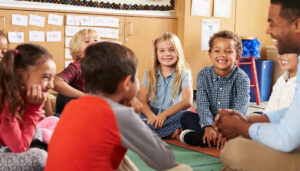It’s widely found that men and women communicate differently at work, at home, and in everyday life, and this applies in classrooms as well. However, how do the dynamics change in a same-sex learning environment – and is this difference good or bad? Are same-sex classrooms education’s solution to differences in gender communication, or can we improve how co-ed classrooms work instead? Although gender communication is different depending on whether a classroom is co-ed or single-sex, it’s important to create a more equal learning environment, especially in co-ed classrooms.

So how does gender communication differ between single-sex and co-ed classrooms? It actually isn’t as simple as the “boys talked more and didn’t realize it” conclusion. In their study, Foster and Newman-Baker found that beyond the amount they were talking (or not), the specific language girls used was very different to the boys: “Girls also tend to use more qualifying language, such as ‘I think’ or ‘maybe,’ when participating in mixed-sex discussions, while boys are more likely to make declarative statements and use stronger language”.1
Boys’ communication was more assertive, while girls’ was not. Boys were also “more likely to interrupt, and more likely to challenge their teacher”2 , again displaying more “aggressive” communication styles. This type of communication resonated with teachers, who then called on boys more. 3 As a result, girls participated more in “cooperative learning experiences,” such as group projects, “where they have greater control over the conversation”,4 potentially because their teachers were not present.This type of behavior can distract students very easily. It is common that boys do interrupt more and get called out, this is turn, affects the other students and their ability to learn in a stimulating environment.
Meanwhile, in same-sex classrooms, the dynamics were very different. Binder and Wood found that communication styles did not change, but instead one dominated: “In girls’ classes, discussion and interaction were used as strategies for promoting learning, whereas in boys’ classes, competition and a focus on performance and grades were more prevalent”.5 Each gender was still communicating in the way they generally preferred – women more cooperatively and men more aggressively – but without the presence of the other gender, the classrooms saw different results. Interestingly, the study found that both genders could benefit from same-sex classrooms, free to explore their interests “without the influence of gender stereotypes and expectations”.6 While same-sex classrooms have its benefits due to similar behaviors from peers, boys need girls and girls need boys. It’s important for mixed-gender interactions to happen at a young age so that as kids develop they have the ability to communicate well with anybody.

Despite these benefits, experts are not so quick to proclaim same-sex education the solution to gender communication problems in the classroom. Armor argues that “Single-sex education may not prepare students for the real-world gender dynamics they will encounter outside of school, where they will need to navigate mixed-gender environments and work collaboratively with people of different genders”.7 As Binder and Wood’s article showed, communication does not “normalize” in same-sex environments – it only heightens the differences in communication styles and allows one to dominate freely. Once students enter a co-ed university or the workplace, the same issues seen in co-ed classrooms would most likely arise again – and even more, students would be unprepared for it.
With this in mind, how can co-ed learning environments acknowledge gender differences in communication and adjust for them? The first step is accepting that the differences exist, and that they themselves may carry a bias for “male” styles of communication. Foster and Newman-Baker in fact agree that teachers’ own communication style can positively affect this issue: they suggest “being aware of their own behavior and language” and “modeling gender-inclusive language…for their students” 8 Beyond communication, teachers can also switch up their classroom formats to make space for girls’ communication styles: “group work or small group activities, which may be particularly beneficial for girls”. 9

Overall, studies on this topic agree that gender communication differences are present even in the classroom, but they point to the conclusion that same-sex education may not be the best solution for this issue. Instead, unlearning biases, incorporating more inclusive communication, and adjusting classroom activities will go farther in allowing both genders (and their communication styles) to thrive in harmony.
In multi-gendered classrooms, it is necessary for students to learn to interact with each other but also be able to collaborate with the opposite gender successfully. In classrooms, it is specifically important that teachers know how to navigate and provide experiences that will encourage open communication, teamwork, and inclusivity. For example, a helpful way to make the students learn from each other would be to split a class into small groups and give an assignment that requires different skills.
Modern-day schools should find a way to incorporate more controversial topics into their everyday discussions. Discussions that focus on gender equality can challenge the stereotypes society once had. However, the most important thing is having a teacher willing to encompass those values and use the appropriate language.
Parents that have older kids in schools should also be willing to have difficult conversations at home, having open conversations with older children really helps them be more open with others and more inclusive. Creating an inclusive, safe environment is a team effort involving teachers, parents, and the students themselves, doing it correctly can result in a positive learning experience for everyone.
- Binder, Amy J., and Kate Wood. “Gender and Learning in Single-Sex Classes: A Multi-Level Analysis of Test Scores and Classroom Climate.” Journal of Educational Psychology 99, no. 2 (2007): 330-41.,80 ↵
- Armor, David J. “Single-Sex versus Coeducational Schooling: A Systematic Review.” The Journal of School Choice 3, no. 1 (2009): 48-87.,80 ↵
- Binder, Amy J., and Kate Wood. “Gender and Learning in Single-Sex Classes: A Multi-Level Analysis of Test Scores and Classroom Climate.” Journal of Educational Psychology 99, no. 2 (2007): 330-41.,338 ↵
- Armor, David J. “Single-Sex versus Coeducational Schooling: A Systematic Review.” The Journal of School Choice 3, no. 1 (2009): 48-87.,80 ↵
- Binder, Amy J., and Kate Wood. “Gender and Learning in Single-Sex Classes: A Multi-Level Analysis of Test Scores and Classroom Climate.” Journal of Educational Psychology 99, no. 2 (2007): 330-41,334 ↵
- Binder, Amy J., and Kate Wood. “Gender and Learning in Single-Sex Classes: A Multi-Level Analysis of Test Scores and Classroom Climate.” Journal of Educational Psychology 99, no. 2 (2007): 330-41,336 ↵
- Foster, Michele, and Susan Newman-Baker. “Gender Differences in Classroom Interactions: An Analysis of Three Disciplines.” Women’s Studies Quarterly 28, no. 1/2 (2000): 76-88.,84 ↵
- Foster, Michele, and Susan Newman-Baker. “Gender Differences in Classroom Interactions: An Analysis of Three Disciplines.” Women’s Studies Quarterly 28, no. 1/2 (2000): 76-88.,87 ↵
- Foster, Michele, and Susan Newman-Baker. “Gender Differences in Classroom Interactions: An Analysis of Three Disciplines.” Women’s Studies Quarterly 28, no. 1/2 (2000): 76-88.,87 ↵




18 comments
Carlos Alonzo
The topic on communication in a single sex or co-ed classrooms has many different facets. A common theme throughout each humanitarian article is that there must be open communication between people to understand these complex issues. With that, student-teacher dynamics must have a balanced approach to consider positive communication in either classroom setting. Congrats on the nomination!
Illeana Molina
Congratulations on your nomination! I love this article as it has been heavily debated upon whether it is best for parents to put their kids in a single-sex or coed classroom. I personally would have hated being in a same-sex classroom/school as it may be too much drama or issues. However, attending a co-ed school was helpful as it prepared me for the real world. I like that this topic is considering the pros and cons as well as researching various approaches and or thoughts. I believe this should not be a universal decision made by someone else. This should be unique and personally discussed with the family and or student.
Aaron Astudillo
Congratulations on the nomination! I commend this particular article as I have recently had a debate in my gender politics class over single-sex classrooms. Thus, I would agree that more conversations should include gender, as it is a topic of hot debate in this current age. However, it is a great topic to increase progression.
Gabriella Parra
Mariana! Congratulations on your nomination! I have never considered the effect of same-sex learning environments. I did not even know they were a thing! That being said, they were very interesting to learn about. It’s interesting that you brought up how gender-specific behaviors might affect other students in the learning environment. I can see how this is important to discuss since social issues can take away from a safe learning environment.
Peter Alva
As someone who went to a same-sex school. I think that it was certainly tough at times and the learning and sometimes it was fun. I do think that some kids are able to thrive in environments like that. I definitely do think that having a co-ed system makes a far better experience and helps some students have better social skills.
Abbey Stiffler
Congrats on your nomination for your article! As I read your article, I started to consider various class discussions I’ve been in and if I could recall how guys and girls would respond and how they would differ from one another. Men and women generally communicate in different ways at work, at home, and in daily life; this also holds true in classrooms.
Kristen Leary
This was a really interesting article! I like how you acknowledged that boys and girls have differences particularly in the way they communicate and interact with each other. A classroom full of boys looks very different from a classroom full of girls and there is not denying there are differences. I’d be interested to see more about how teachers can incorporate strategies to benefit both boys and girls in a co-ed setting.
Barbara Ortiz
Congratulations on your nomination for such a great article. I really enjoyed your article since this applies well to my planned area of studies of history and education. Right now I am in a class for diverse populations where we talk mostly about different abilities and physical and mental challenges. We did not discuss one of the fundamental challenges of teaching the opposite sexes in a classroom and how to ensure all taught to voice and where all voices are heard.
Alanna Hernandez
Communication between the sexes has and will always be complicated and in the classroom you see it exemplified even more. The break down of the differences was clear and explained so much of my life experiences in the classsroom. It is better to make the two clash early so we are able to ádrese and adjust as needed later on and apply that in the real world
Nnamdi Onwuzurike
Congratulations on your nomination! This article explores the debate over whether communication is better in single-sex or co-ed classrooms. The author discusses research on the topic and considers the potential benefits and drawbacks of each approach. While the answer is not clear-cut, the article highlights the importance of creating classroom environments that support effective communication and learning, regardless of the gender composition of the class. Ultimately, the best approach may vary depending on a variety of factors, including the age and developmental stage of the students and the goals of the classroom instruction.